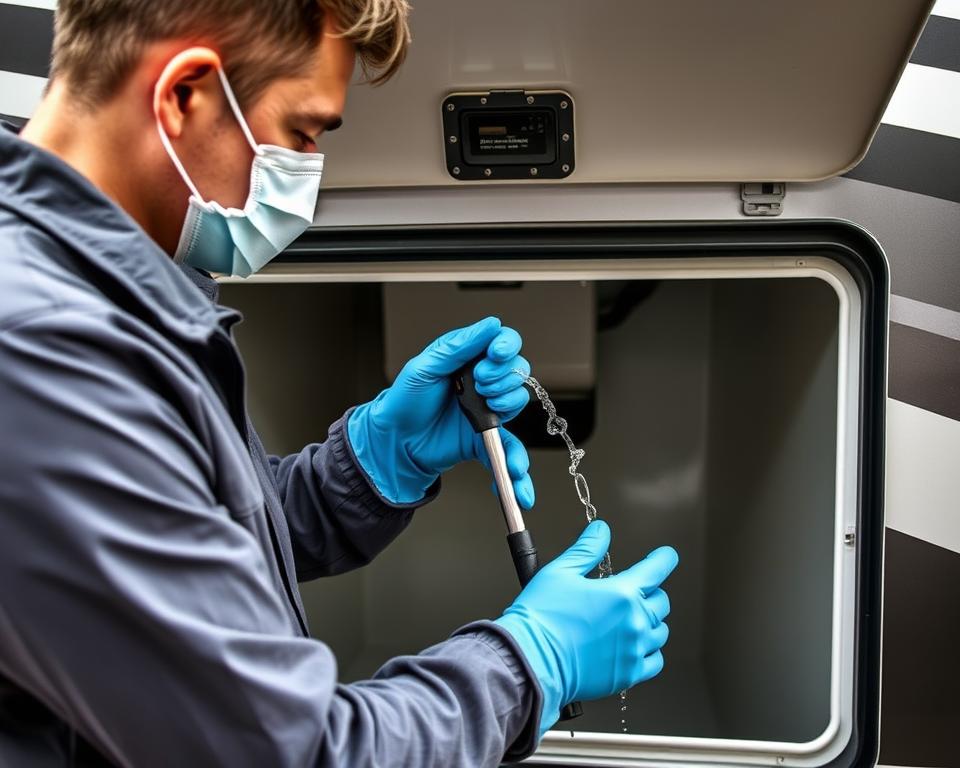Recreational Vehicle Sewage Pump Handbook: Vital Upkeep Recommendations
Ever considered the workings of your camper’s waste disposal system? Being aware of the intricacies of your RV waste pump can avert mishaps, enhancing your outdoor adventures. It’s centered on overseeing waste efficiently and dodging noxious odors. By following this guide, you’ll discover vital maintenance methods for RV pumping near me. Each created to maintain your waste system’s peak performance.
Understanding Your RV Sewage Pump Network
The RV sewer pump system is vital for sewage control, making camping more pleasant. It features two principal tanks: the black-water reservoir for bowel output and the grey water tank for water from wash stations. Differentiating these tanks is key to prevent clogs and keep your RV operating smoothly.
An camper macerator unit is a popular choice for sewage handling. It grinds solid waste into tiny bits, facilitating disposal. Alternatively, you can choose, a standard waste pump is available. It competently moves waste without shredding, for those seeking a simpler option.
Knowing your RV’s sewer pump system is vital to stopping problems and ensuring hassle-free checks. Using the system effectively can prevent messes, enhancing your outdoor adventures.
Value of Regular Service
Maintaining your RV waste pump is vital for a hassle-free adventure. Without proper maintenance, you may experience odors, clogs, or backups. These complications can ruin your road trips.
Consistent servicing prevent such snags and lengthen your system’s life. By checking hoses and seals, you enhance efficiency. A properly cared-for RV sewage pump provides clean waste handling, letting you enjoy continuous journeys.
Regular servicing also brings financial savings over time. Lack of care can cause costly breakdowns, requiring expensive replacements. Putting resources into regular maintenance keeps your motorhome in optimal state, preserving money long term.
Recommended Frequency for RV Septic Tank Pumping
Knowing the right time to pump your RV Septic tank is key for its upkeep. It’s best practice to pump every 3–5 days during use. For weekend journeys, pumping on return may work fine.
Frequency depends on different variables. Tank capacity and usage level are key. Ideally pump when it reaches two-thirds full. This helps maintain smooth flow and prevent clogs.
Checking your RV tank fill level is vital for a pleasant excursion. Manage your camper’s effluent to avoid issues while traveling.

Optimal Methods for Tank Disposal
Properly emptying RV tanks is crucial for your motorhome’s cleanliness and performance. Begin with the black tank to let the grey tank liquid rinse leftover solids. This technique stops clogs and ensures efficient drainage.
Opt for a durable drain hose for disposal. A heavy-duty hose prevents leaks and secures connections. Attach a tank rinser for a intensive cleanse, using water pressure to remove lingering waste, boosting cleanliness.
Complete purging prevents residue buildup, preventing foul odors and potential issues. To maintain an optimal sewage system in your motorhome, implement these guidelines:
- Always add a tank treatment after emptying to control odors and break down waste.
- Keep an eye on fill levels to avoid overflows.
- Check your RV sewer pump often for clogs and wear.
- Deep rinse tanks each month or twice monthly, even during infrequent outings.
Following these methods enhances your sewage system’s lifespan and efficiency, ensuring smooth journeys.
Keeping Smells and Blockages at Bay
For a memorable adventure, avoiding stench is key. Maintain adequate water level to aid in waste breakdown, warding off unpleasant odors. Also, using RV-safe toilet paper helps prevent clogs, keeping the system running smoothly.
For better sewage management in campers, try enzyme-based tank treatments. These process sludge thoroughly, streamlining care. Check the vent line often to keep air moving freely in the plumbing system.
Mindful disposal is vital to avoiding tank issues. Avoid flushing wipes, feminine products, and paper towels. These non-compostable materials can cause significant obstructions. Following these tips helps maintain a tidier camping environment.
Care Recommendations for RV Waste Pumps
Maintaining your RV’s sewer pump system is essential for trouble-free travels. Inspect dump valve seals regularly to avoid drips. Worn seals can cause accidents, harming your RV.
To remove stench and maintain cleanliness, sanitizing is vital. Perform a deep clean every few months to prevent buildup, ensuring the system performs reliably. These steps are necessary for maintaining a on-board grinder, promoting extended service and reliable functionality.
Greasing valve components is another vital task. It helps ward off seepage and improve functionality. Monitoring tank sensors is key for precise measurements, preventing overflows and unexpected pump issues. Regularly reviewing these points makes your RV adventures more sanitary and more enjoyable.
Clues for Hiring a Professional Pump Service
Identifying septic problems ahead can protect you from costly repairs. A primary clue you need a expert emptying is delayed emptying. When sinks and toilets take longer to clear, it often points to obstructions. It suggests your system may be clogged.
Persistent odors are another clear sign of sewage troubles. Unpleasant fumes hanging around despite cleaning suggest trapped waste. It’s crucial to check the transparent elbow fitting when dumping waste. Visible residue signals it’s time for pro maintenance.
Technicians employ water-jet systems to break up hard obstructions efficiently. Neglecting these signs can snowball major problems. Therefore, it’s vital to seek help immediately when issues arise.
| Indicators of Sewer Trouble | Suggested Steps |
|---|---|
| Slow Draining | Inspect for clogs; arrange professional pump-out |
| Ongoing Foul Scents | Inspect fittings; schedule pump-out |
| Obvious Debris | Contact pump service for thorough cleaning |
Deciding on the Best RV Macerator Unit
When selecting an RV macerator pump, evaluate its capacity, build quality, and compatibility with your RV’s size. A top-notch macerator is essential for smooth sludge processing. This is especially crucial for RVs requiring regular emptying. High-end pumps optimize sewage handling, ensuring a problem-free adventure.
Various units cater to different preferences. For an well-founded selection, focus on these main points:
- Capacity: Verify capacity matches your usage.
- Durability: Opt for models built to endure travel demands.
- Ease of Use: Choose devices that simplify installation and operation.
- Compatibility: Verify the pump fits your RV plumbing.
Carefully considering options when choosing an RV macerator pump improves travel enjoyment and ensures proper sewage disposal.
Fixing Common RV Pump Issues
Accurate diagnosis for your RV sewer pump is vital in resolving common sewage issues before they worsen. If you notice lethargic outflow, unexpected backups, or persistent odors, act quickly. These are obvious indicators of malfunction requiring attention.
Start with checking the pump, its connections, and hoses. Search for any clogs that could slow flow. Ensure inlet and outlet fittings are secure. Also, verify the pump’s power supply for stability.
If basic checks fail to reveal the issue, note the pump’s sound. A unit that’s overly noisy or too quiet may have internal damage. Also, inspect for leaks, as these can exacerbate sewage problems. With these troubleshooting steps, many RV owners identify and resolve issues early, avoiding costly repairs.
Sustained Maintenance for RV Sewer Pumps
For continued reliability, commit to regular sewer pump upkeep. Flush the system consistently to prevent clogs. Set up and adhere to a maintenance routine, keeping everyone informed of their roles. This significantly extends your waste system’s lifespan.
Educating yourself and others on correct flushing habits is vital. This preventss issues and fosters shared responsibility. The result benefits both users and the sewer system.
- Regularly check hoses and fittings
- Cleaning filters regularly
- Arrange yearly pro maintenance
- Apply recommended conditioners
Abiding by these practices boosts your camper’s sewage system’s durability and keeps it functional, making travels more comfortable.
To Summarize
Caring for your RV sewer system diligently is crucial for uninterrupted camping adventures. Regular attention to RV sewer system maintenance markedly cuts problem risks, letting you focus in the journey. By knowing your system and applying reliable sewage methods, your trips will be free of waste management woes.
Using the key tips from this guide promotes RV waste management and uplifts your travel comfort and safety. Maintain peak performance by following best upkeep practices and tackling potential issues promptly.
Staying vigilant about your RV sewer system brings dividends. It provides homely comforts while exploring. Here’s to joyous and untroubled journeys!
Frequently Asked Questions
How do I know when it’s time to pump my RV Septic tank?
Service the tank at two-thirds fullness to optimize flow.
How do black and grey tanks differ?
The black tank holds toilet waste. Whereas, the grey tank collects water from sinks and showers.
How often should I maintain my RV sewer pump system?
Inspect and sanitize system about every three months.
Recommended products for RV sewer pump maintenance?
Use enzyme-based treatments safe for RVs.
What prevents blockages in RV plumbing?
Use only RV-safe toilet paper.
When should I call a pro for RV pump service?
Blockages, foul scents, or tank overflow warrant expert service.
Making your RV macerator pump work better?
Select a correctly sized pump for your RV.
Key inspection points for a thorough RV sewer cleanse?
Inspect all connections and hoses.
What long-term care tips help my RV sewer pump?
Adopt regular deep cleans and consistent sanitation.
What’s the pumping interval for frequent RV use?
Schedule pump-outs every 3–5 days.
